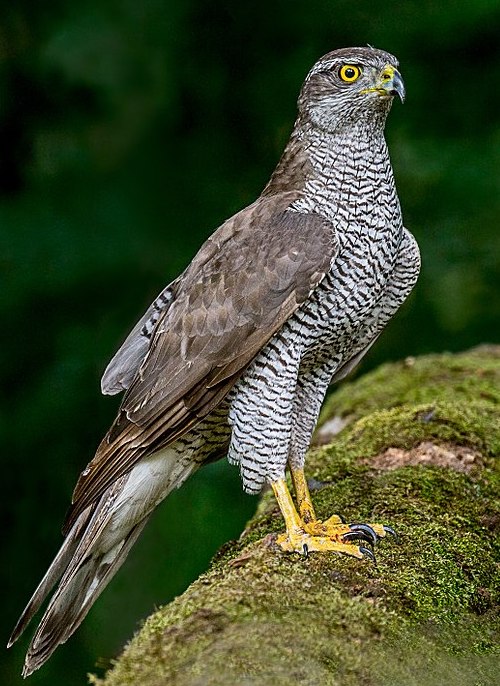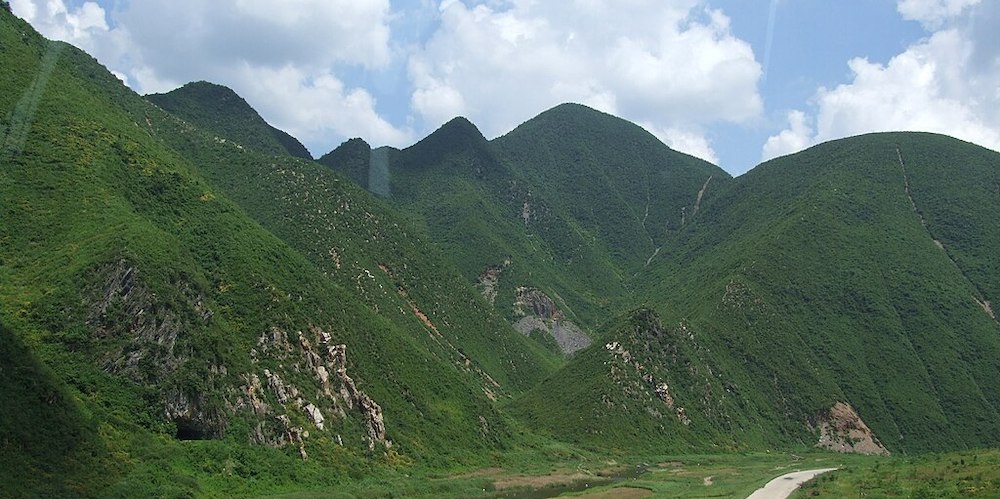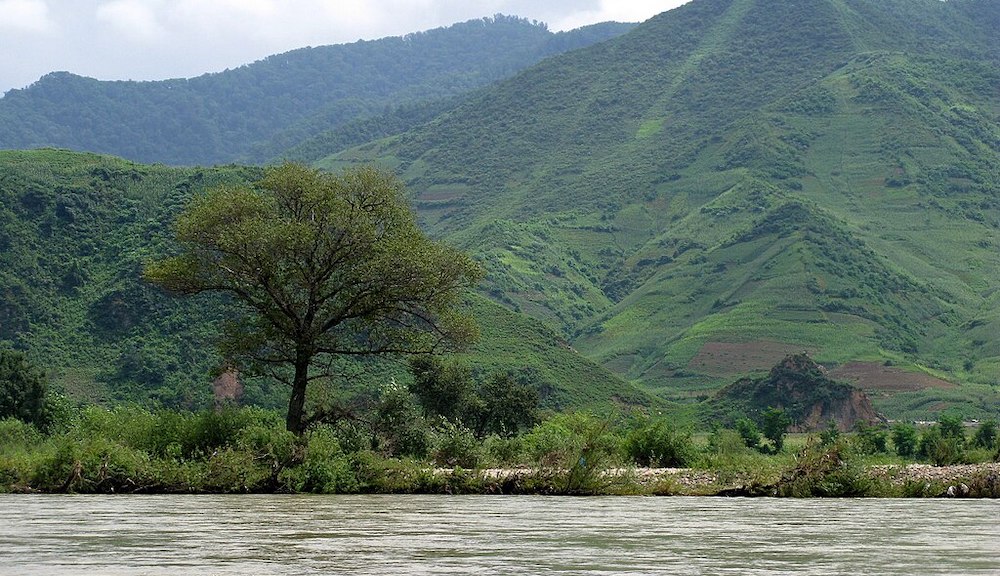Democratic People’s Republic of Korea

North Korea, officially the Democratic People’s Republic of Korea (DPRK), is a state in East Asia, occupying the northern half of the Korean Peninsula. It covers an area of 120,538 km2 (46,540 square miles) ((roughly the size of the American state Pennsylvania) with a population of around 24.5 million people. Its capital and largest city is Pyongyang with over three million inhabitants. The border between North Korea and South Korea is called the Korean Demilitarized Zone. The Yalu (Amnok) River is the border between North Korea and China. The Tumen River in the extreme north-east is the border with Russia. The country’s western border is formed by the Yellow Sea, while its eastern border is defined by the Sea of Japan. North Korea, like its southern counterpart, claims to be the sole legitimate government of the entire peninsula and adjacent islands.
Early European visitors to Korea remarked that the country resembled “a sea in a heavy gale” because of the many successive mountain ranges that crisscross the peninsula. Some 80 percent of North Korea is composed of mountains and uplands, separated by deep and narrow valleys. All of the Korean Peninsula’s mountains with elevations of 2,000 meters (6,600 ft) or more are located in North Korea. Hamgyong Range is in the extreme northeast and the Rangrim Mountains are located in the north-central part of North Korea. The Taebaek Range, which extends into South Korea, is famous for its scenic beauty.

Mountains near Gaeseon – ©Nicor CC BY-SA 3.0 < >, via Wikimedia Commons
The coastal plains are wide in the west and discontinuous in the east. A great majority of the population lives in the plains and lowlands. According to a United Nations Environmental Programme report in 2003, forest covers over 70 percent of the country, mostly on steep slopes. The longest river is the Amnok (Yalu) River which flows for 790 kilometres. The country contains three terrestrial ecoregions: Central Korean deciduous forests, Changbai Mountains mixed forests, and Manchurian mixed forests.

Yalu River – ©Caitriana Nicholson CC BY-SA 2.0 via Wikimedia Commons
North Korea experiences a humid continental climate. Winters bring clear weather interspersed with snow storms as a result of northern and northwestern winds that blow from Siberia. Summer tends to be by far the hottest, most humid, and rainiest time of year because of the southern and southeastern monsoon winds that carry moist air from the Pacific Ocean. Approximately 60 percent of all precipitation occurs from June to September. The daily average high and low temperatures for Pyongyang are −3 and −13 °C in January and 29 and 20 °C in August.
Birding North Korea
The wildlife of Korea belongs to the Palaearctic realm. Native or endemic species of the Korean Peninsula include Korean hare, Korean water deer, Korean field mouse, Korean brown frog, Korean pine and Korean spruce. The 250 mile long Korean Demilitarised Zone (DMZ) with its forest and natural wetlands is a unique biodiversity spot, which harbours 82 endangered species such as red-crowned crane, Amur leopard and the Siberian tiger. Overall, it is home to about 70 mammals, more than 300 birds and about 3,000 plants. On the rest of the peninsular, the populations of bears, lynx tigers, wolves, dholes and leopards, are presently very rare or extirpated, and likewise large ungulates (with the exceptions of roe deer, water deer and wild boar) are uncommon. North Korea is home to under 400 of the species of birds of the peninsular as a whole.

©David Clayton Ellsworth CC BY-SA 4.0 via Wikimedia Commons
According to Young Pioneer Tours the Chilbo mountains in the northeast contain mixed broadleaf and coniferous forest, similar to the smaller Kuwol mountains in the southwest. The Kumgang mountains in the southeast are home to Red-crowned Cranes and along with the more central Myohyang mountains these areas are all national parks of significant birding potential. Lake Bujon is an important area because of a significant population of Great Bustards. One of the best places to go is Mundok Migratory Bird Reserve on the west coast near Anju city, as it is a key stopover for hundreds of species of migratory birds including many endangered species.
-
Wikipedia
GNU Free Documentation License
https://en.wikipedia.org/wiki/North_Korea
-
Number of bird species: 389
(As at January 2025)National Bird: Northern Goshawk Accipiter gentilis
-
Avibase
PDF ChecklistThis checklist includes all bird species found in North Korea , based on the best information available at this time. It is based on a wide variety of sources that I collated over many years. I am pleased to offer these checklists as a service to birdwatchers. If you find any error, please do not hesitate to report them. -
Bird ID
Annotated ListIllustrated -
Wikipedia
Annotated ListThis is a list of the bird species recorded in North Korea. The avifauna of North Korea include a total of 386 species, one of which is introduced. -
eBird
PDF ChecklistThis checklist is generated with data from eBird (ebird.org), a global database of bird sightings from birders like you. If you enjoy this checklist, please consider contributing your sightings to eBird. It is 100% free to take part, and your observations will help support birders, researchers, and conservationists worldwide.
-
A Field Guide to the Birds of Korea
| By Woo-Shin Lee, Tae-Hoe Koo & Jin-Young Park | LG Evergreen Foundation | 2015 | Edition 2 | Paperback | 395 pages, 120 plates with colour illustrations; b/w illustrations, colour distribution maps | Out of Print | ISBN: 9788995141533 Buy this book from NHBS.com -
Birds of East Asia Eastern China, Taiwan, Korea, Japan, Eastern Russia
| By Mark Brazil | Helm | 2009 | Paperback | 528 Pages, 234 Colour Plates, maps et al | ISBN: 9780713670400 Buy this book from NHBS.com
-
NP IBA Chilbosan (North Hamgyong)
InformationSatellite ViewMajor part of the mountain is covered by mixed broadleaf and coniferous forest and protected in a 30,000 ha national park. It has been identified by BirdLife International as an Important Bird Area (IBA) because it supports populations of Oriental storks and critically endangered Baer's pochards. -
NP IBA Kuwolsan
InformationSatellite ViewThe highest peak of the mountain - the highest point in the short Kuwol range - is 954 m above sea level. There are several scenic routes through the mountain area. Natural attractions include rock formations, waterfalls and natural pools. Much of the mountain is covered by mixed broadleaf and coniferous forest and protected in an 18,000 ha national park. Some 1100 ha has been identified by BirdLife International as an Important Bird Area (IBA). -
NP IBA Lake Bujon
InformationSatellite ViewIt has been identified by BirdLife International as an Important Bird Area (IBA) because it supports a significant population of vulnerable great bustards -
NP IBA Mount Kumgang
InformationSatellite ViewIt is located on the east coast of the country, in Mount Kumgang Tourist Region, formerly part of Kangwŏn Province (38.58°N 128.17°E). Mount Kumgang is part of the Taebaek mountain range which runs along the east of the Korean Peninsula. Much of the mountain is covered by mixed broadleaf and coniferous forest and protected in a 60,000 ha national park. Some 25,000 ha has been identified by BirdLife International as an Important Bird Area (IBA) because it supports endangered red-crowned cranes -
NP IBA Myohyangsan
InformationSatellite ViewMuch of the mountain is covered by mixed broadleaf and coniferous forest and protected in a 16,000 hectares (62 sq mi) national park. Some 7,000 hectares (27 sq mi) has been identified by BirdLife International as an Important Bird Area (IBA) -
NR IBA Ogasan
InformationSatellite ViewThe Ogasan Nature Reserve is a national park located in North Korea. It is situated around Mount Oga, which straddles the borders of Hwap'yŏng county in Chagang Province and Kimhyŏngjik county in Ryanggang. Rising to 1204 m above sea level, the park covers 6000 ha, including 800 ha of some of the oldest old-growth forest in North Korea, and more than 1330 species of plants and animals. The mountain hosts a diverse variety of plant and animal life, including both boreal and temperate species, which are divided into different zones of broadleaved, mixed and coniferous forests as one ascends the mountain. The site has been identified by BirdLife International as an Important Bird Area (IBA) -
NR Mundok Migratory Bird Reserve
InformationSatellite ViewMundok Migratory Bird Reserve is one of two Sites designated as a Wetland of International Importance on the accession of the Democratic People's Republic of Korea to the Convention on Wetlands.
-
Young Pioneer Tours
Local Tour OperatorYoung Pioneer Tours can organise birdwatching private tours or organise bird survey tours to various parts of the DPRK
-
2019 [06 June] - Adrian Riegen
ReportNaturalists from New Zealand and the Nature Conservation Union of Korea completed a survey of shorebirds in the DPRK
-
Birds without borders: Bird watching in North Korea
Article...What we find is astonishing, the bird utopia the Miranda birders had been hoping to find. A beautiful pristine habitat for tens of thousands of hungry godwits that the rest of the world knew nothing about...

